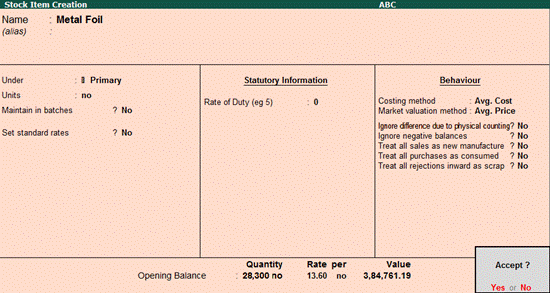
A mismatch between the opening stock and closing stock values was observed in the following cases:
a. While creating a stock item, if the Quantity and Value were specified in the Opening Balance , the rate calculated was truncated (cut short) to 5 decimal places. As a result, the closing stock of the stock item was being recalculated on the truncated rate. Hence, in the Stock Summary and other inventory reports, there was a mismatch in the opening and closing stock values. Click here to understand with an example.
In Release 5.5.5, this issue has been resolved. To upgrade to Release 5.5.5, click here .
b. When transactions are passed to record movement of stock items, inwards or outwards, the closing stock value is calculated based on the rate derived from the costing method applied. As a result, a mismatch occurs between the opening and closing stock values. To read more, click here .
In the Stock Item Creation screen, the Quantity is specified as 28,300 and the Value is specified as Rupees 384761.19. The actual rate calculated is Rupees 13.595801766. However, before Release 5.5.5, this rate was getting truncated (cut short) to 5 decimal places i.e., 13.59580.
Note: In the Stock Item Creation screen, the rate is displayed based on the round off method set for the company.
In this example, the round off method is set to 2 decimal places. Hence, the rate the displayed as 13.60, as shown below:

The closing balance was then recalculated based on this truncated value i.e., 28300*13.59580 = 384761.14, as shown below:

H ence, there was a mismatch in the opening and the closing balances.
This behavior was observed when following costing methods were applied:
● Average Cost
● Monthly Average Cost
This issue has been resolved in Release 5.5.5. The opening balance matches the closing balance in Release 5.5.5, as shown below:

When transactions pertaining to stock items are passed, the closing balance is recalculated based on the costing method applied.
Consider the following example:
Two inward transactions for metal foil are passed, as shown below:
|
Transaction |
Quantity |
Value |
|
Purchase |
142985 |
471672 |
|
Purchase |
28300 |
384761.19 |
Under the Average Cost method,
The average cost for the stock item is = (471672+384761.19)/ (142985+28300) = 5.00004
The closing balance is = 5.00004*171285 = 856431.85
As a result, you will find a mismatch between the Inwards value and the Closing value, as shown below:

This mismatch is caused due to the costing method used.